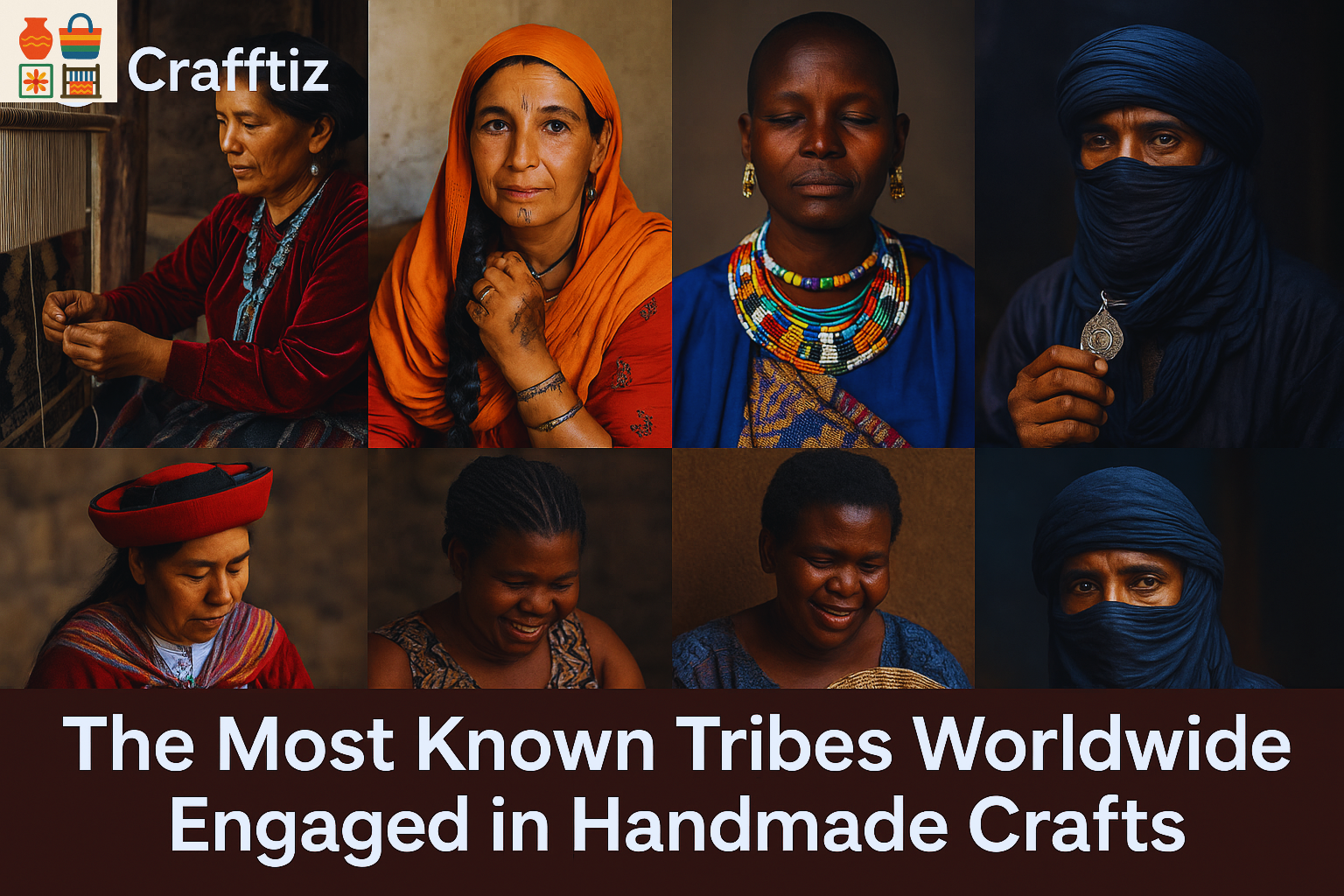أشهر القبائل التي تعمل في مجال الحرف اليدوية في العالم.
مقال: فريق كرافتز التحريري adminuser • October 5, 2025

تمثل الحرف اليدوية التقليدية أكثر من مجرد منتجات جميلة؛ فهي تعبير حي عن الهوية، والتاريخ، والثقافة.
في جميع القارات، حافظت قبائل ومجتمعات أصلية على تقاليدها الحرفية عبر مئات السنين، فساهمت في تشكيل التراث الإنساني والإلهام الفني العالمي.
في هذا المقال، نستعرض لكم أبرز القبائل حول العالم المعروفة بحرفها اليدوية الفريدة، وتقنياتها التقليدية التي ما زالت حية حتى اليوم.
1. قبائل النافاهو (Navajo) – الولايات المتحدة الأمريكية
الشهرة في: النسيج اليدوي، المجوهرات بالفيروز، الرسم بالرمل
تشتهر قبائل النافاهو في الجنوب الغربي للولايات المتحدة بـ النسيج اليدوي المميز باستخدام الأنوال العمودية، وتصاميم هندسية جريئة بالألوان الطبيعية.
كما تشتهر بصياغة الفضة والفيروز، التي أصبحت رمزًا ثقافيًا عالميًا يعكس ارتباطهم بالأرض والروحانية.
لماذا تعتبر منسوجات النافاهو ثمينة؟
لأنها تُصنع يدويًا بالكامل وتستغرق شهورًا، مما يجعل كل قطعة فريدة وتحمل قيمة تاريخية.
________________________________________
2. الأمازيغ (القبائل البربرية) – شمال إفريقيا (المغرب، الجزائر، تونس)
الشهرة في: صناعة السجاد، الجلود، الفخار، الفضة
الأمازيغ هم حراس التراث الحرفي في شمال إفريقيا.
تشتهر النساء الأمازيغيات بـ حياكة السجاد التقليدي المزين برموز تعكس التاريخ العائلي والمعتقدات الروحية.
كما تُعرف فخاريات تامغروت المغربية والمنتجات الجلدية المشغولة يدويًا بجودتها العالية وجمالها الفريد.
كلمات مفتاحية شائعة: سجاد أمازيغي، فضة مغربية، حرف يدوية تقليدية من شمال إفريقيا.
________________________________________
3. الماساي – كينيا وتنزانيا
الشهرة في: فنون الخرز، المجوهرات التقليدية، الأزياء المزخرفة
تشتهر نساء قبائل الماساي بإبداعهن في فن الخرز الملون، حيث تعبر الألوان عن معانٍ اجتماعية وروحية عميقة.
الأحمر يدل على الشجاعة، الأزرق يرمز للطاقة والسماء، والأبيض يعكس النقاء والصحة.
تُستخدم هذه القطع في الاحتفالات والمناسبات، كما أصبحت رمزًا للفخر الثقافي الإفريقي.
________________________________________
4. الكيتشوا (Quechua) – بيرو ومنطقة الأنديز
الشهرة في: المنسوجات من صوف الألباكا، التطريز، الأصباغ الطبيعية
يحافظ شعب الكيتشوا على تقاليد الأنسجة الإنكا القديمة باستخدام صوف الألباكا الطبيعي.
تُستخدم أصباغ نباتية لإنتاج ألوان زاهية، وتُزين الأقمشة برموز تمثل الجبال والأساطير والحيوانات.
كما سُجلت هذه الحرف ضمن قائمة التراث غير المادي لليونسكو.
5. الزولو – جنوب إفريقيا
الشهرة في: صناعة السلال، الخرز، الفخار
تشتهر قبائل الزولو بـ نسج السلال المحكمة باستخدام نخيل الإلالا وأصباغ طبيعية.
كما أن الخرز الزولو يحمل معانٍ رمزية دقيقة تتعلق بالهوية والحب والمكانة الاجتماعية.
تستغرق صناعة سلة زولو يدوية أسابيع، وتعكس مهارة وإبداعًا عريقًا.
6. الشعوب الأصلية – أستراليا
الشهرة في: الرسم بالنقاط، النسيج، النقش على الخشب، الرسم على اللحاء
تعبر القبائل الأصلية الأسترالية عن قصصهم الروحية (Dreamtime) من خلال لوحات النقاط والفنون اليدوية التقليدية.
تتميز أعمالهم بعمقها الرمزي وارتباطها بالأرض والأسلاف، وهي اليوم من أبرز رموز الفن الأسترالي المعاصر.
7. قبائل الأوتومي – المكسيك
الشهرة في: التطريز اليدوي، المنسوجات، الورق التقليدي (Papel Amate)
يشتهر شعب الأوتومي بإبداع تصاميم التطريز الحيوية التي تجمع بين الحيوانات والزهور والكائنات الأسطورية.
أصبحت هذه المنسوجات مطلوبة عالميًا في عالم الديكور والموضة.
كلمات مفتاحية: تطريز أوتومي، منسوجات مكسيكية، فنون تقليدية.
8. الطوارق – الصحراء الكبرى
الشهرة في: المجوهرات الفضية، الجلود، الأقمشة المصبوغة بالنيلي
يعرف الطوارق بـ “الرجال الزرق” بسبب ملابسهم النيليّة المميزة.
يصنعون مجوهرات فضية هندسية وحقائب جلدية بدقة متوارثة عبر الأجيال.
تصاميمهم البسيطة والأنيقة أصبحت موضع إعجاب عالمي.
أهمية هذه القبائل في سوق الحرف اليدوية اليوم
في عصر الإنتاج الصناعي السريع، تمثل هذه القبائل الأصالة، والاستدامة، والهوية الثقافية.
دعمهم يعني الحفاظ على تقاليد مهددة بالاندثار، وتمكين المجتمعات المحلية – خاصة النساء – من مصدر دخل مستدام.
منصات مثل Crafftiz.com تتيح لهؤلاء الحرفيين فرصة عرض منتجاتهم مجانًا أمام جمهور عالمي، دون رسوم إدراج، مما يساعد على وصول حرفهم إلى العالم مع الحفاظ على جذورها.
الأسئلة الشائعة (AEO)
لماذا تعتبر الحرف القبلية مهمة للاقتصاد العالمي؟
لأنها تدعم الاقتصاد المحلي، وتحافظ على التراث الثقافي غير المادي، وتلهم الصناعات الإبداعية الحديثة.
أين يمكن شراء منتجات حرفية أصلية؟
من خلال منصات موثوقة مثل Crafftiz.com أو التعاونيات المحلية التي تضمن أصالة المنتج ودعم الحرفيين مباشرة.
ما هي القبائل التي اعترفت بها اليونسكو لحرفها؟
قبائل الكيتشوا (بيرو)، الأمازيغ (المغرب)، والشعوب الأصلية الأسترالية من أبرز من حصل على هذا الاعتراف
خلاصة
الحرف اليدوية القبلية ليست مجرد فن، بل هي ذاكرة الشعوب وثروتهم الثقافية.
من خلال دعم هذه المجتمعات، نساهم في الحفاظ على تراث إنساني فريد وإحياء اقتصاد محلي مستدام.
👉 انضم إلى Crafftiz.com اليوم، واكتشف عالم الحرف اليدوية الأصيلة من مختلف أنحاء العالم.


